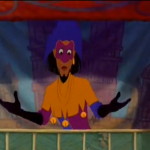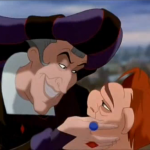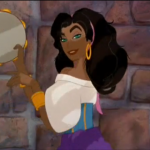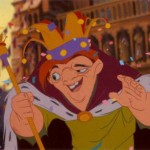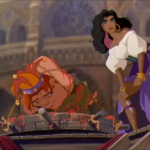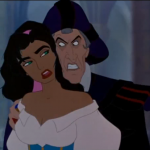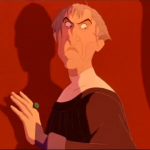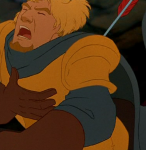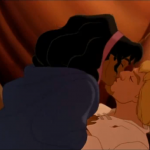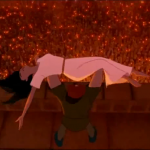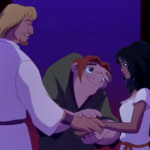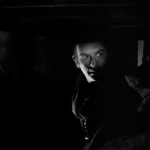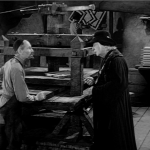The Disney version starts off with Clopin (Paul Kandel) regaling small children with the tale of the mysterious bell ringer and how he came the position. Though a song (The Bells of Notre Dame) and a flashback Clopin tells of a group of Gypsies entering Paris via the Seine, the notable Gypsy is a women with a child. After docking the Gypsies are caught by Judge Claude Frollo (Tony Jay). Frollo doesn’t care much for gypsies and orders their arrest but when he tries to take the baby from the women (he thinks it stolen goods) she runs toward Notre Dame. After the chase Frollo kills the women on the steps of Notre Dame and Frollo tries to drown the child who is deformed. Before Frollo can do it he’s stop by the Archdeacon (David Ogden Stiers) who guilts Frollo into taking care of child but Frollo demands that the child must live in the bell-tower. Clopin then asks us to consider what the bells supposedly say “who is the monster and who is the man”
After a lovely crescendo and the title screen featuring those crazy bells we’re introduced to Quasimodo (Tom Hulce) who is urging a baby bird to fly away as no one wants to be cooped up in Notre Dame forever. After the bird flies away Quasimodo’s gargoyles friends come to life. Victor (Charles Kimbrough), Hugo (Jason Alexander), and Laverne (Mary Wickes(and Jane Withers)). The three urge Quasimodo to go the Festival of Fools but Quasimodo says he forbidden to ever leave the cathedral by his master Frollo. After some a little encouragement he decides to go but Frollo shows up and tries to persuades him out of ever leaving because of his ugliness he’ll only meet with hate. Frollo does with via song (Out There). After Frollo is done singing and leaves Quasimodo takes over the song (Out There), and sings about a desire to have one day out among normal people.
The scene switches to Phoebus (Kevin Klein), Captain of the Guard, returning to Paris. He catches the eye of pretty Gypsy girl, Esmeralda (Demi Moore), dancing for coins. After some other guards show up and accosted Esmeralda for stealing, Phoebus aids in her escape. Phoebus then makes the trouble-making, underling guards guide him to the Palace of Justice. He meets Frollo who explains that Paris must be rid of the Gypsies as they weaken the moral of the otherwise good Parisian and then they head out to the Festival of Fools.
The Festival begins as a clocked Quasimodo swing down from Notre Dame and gets caught up in the festivity of the party as Clopin serves as the master of ceremonies by singing Topsy Turvy . While Quasimodo is getting thrown about he crashes into a tent where Esmeralda is changing. She asks Quasimodo if he is injured and compliments his mask, Quasimodo is instantly smitten with her. Frollo, Phoebus, and guards arrive on the scene and Esmerlada dances for crowd and gets the attention of Quasimodo, Frollo and Phoebus. After that the King of Fools contest starts, as the ugly masses came on to the stage, Esmeralda pulls Quasimodo up on stage. Once it is reveal that Quasimodo “mask” is really his face he is crowned king of fools, much to Frollo’s disapproval.
After the song ends, the underling guards, throws a tomato at Quasimodo causing the crowd to pelt him with foodstuff and tie him down to the pillory. Phoebus wants to intervene but Frollo insists Quasimodo is learning a lesson. The barrage of food ceases when Esmeralda ascends the pillory, and apologizes to Quasimodo. Frollo orders her down and not to help. After a quip about justice and mistreat of people (especially her people) she free Quasimodo. Frollo orders her arrest and a merry chase ensues.
After Esmerlada gives everyone the sip, Quasimodo apologizes to Frollo and returns to Notre dame. Phoebus sees an old man wander into Notre Dame and follows. The old man is Esmerlada who has chosen Notre Dame as hiding place. She senses a presence behind her (Phoebus) and she engages him in combat. As she fights, he flirts, which after a bit works but Frollo interferes demanding her arrest. Phoebus claims she claim sanctuary and he can’t do anything. Frollo demand that she be dragged out side but the good-old Archdeacon commands that Frollo can’t do anything. As Phoebus and the other guards leave, Frollo hides and grabs Esmeralda from the back and says he’ll wait for her to leave and then continues to grope her. He leaves and Esmeralda learns that guards are position all around the cathedral. Esmeralda sings a prayer for not just her people but for all outcast (Good help the Outcast {sung by Heidi Mollenhauer). As she sings Quasimodo hears it and follow it. When the song ends Quasimodo is told off and flee back up to the bell tower, as he flees Esmeralda pursues.
The two becomes friends and learn more about each and how Frollo can be wrong about people. Quasimodo then decide to help Esmeralda escape but climbing down the building. Esmeralda ask Quasimodo to comes with her to The Court of Miracles (the Gypsy haven), but he refuses and she gives him a woven band to help if he needs sanctuary. Quasimodo returns to the tower and his gargoyle tease him about having a girlfriend. He sings a song about his feelings for Esmeralda and hope for love (Heaven’s light). Meanwhile, Frollo is also singing about his lust and obsession for Esmeralda (Hellfire). During the course of the song he learns that Esmeralda has escaped.
The next day, Frollo has order the capture of Esmeralda. He uses force, bribes, and attempted manslaughter. Frollo tries to kill an entire family for harboring Gypsies, he orders Phoebus to burn the house where the family is trap but Phoebus refuses and sentence to death, but a disguised Esmeralda intervenes via rock. Phoebus gets away but is shoot by an arrow and falls into river. Esmeralda saves him.
Meanwhile, Frollo has set Paris ablaze. Quasimodo is worried about Esmeralda’s safety but the Gargoyle assure him that she’s fine and she’ll return to Quasimodo and convinces him that she is in love with (A Guy like you). The song ends with Esmeralda entering the tower and asks Quasimodo to hide Phoebus. As Esmeralda tends to Phoebus‘ wound it became clear that she not into Quasimodo in the romantic sense. Quasimodo hears Frollo coming and Quasimodo tries to cover. Frollo reveals that he knows where the Court of Miracles is and is going to attack. Quasimodo and Phoebus set out to warn the Gypsies. Quasimodo relies that the woven band is a map and they find the Court of Miracles. The pair is ambush by Clopin (Court of Miracles), since the Court of Miracles doesn’t like uninvited guest they going to hang them, but Esmeralda stops them. Phoebus warns them about the attack but Frollo followed them and arrest everyone.
As Frollo prepare to execute Esmeralda, he asks her to chose him or the fire, she choses the later and the pyre is set aflame. Quasimodo then swings down from Notre Dame frees Esmeralda swing back up and yells sanctuary. Frollo the attacks Notre Dame and Quasimodo defends. Everyone get in on the battle, Phoebus, Clopin, the gargoyles, random extra and birds. Quasimodo uses molten lead but Frollo sneaks in.
Quasimodo tells Esmeralda to come see his victory but it seems like she dies of asphyxiation. Quasimodo cries as Frollo slips into the room and tries to kill him but Quasimodo fights back and Esmeralda regains consciences, and Frollo goes on murderous offense. After a bit of fight Frollo is about to win as Esmeralda clings to Quasimodo who is dangling over the edge of Notre Dame but Frollo support gives out and he falls to his death. Esmerlada strength gives out and Quasimodo falls but he caught by Phoebus. Quasimodo then gives the couple his blessing. Esmeralda and Phoebus emerge from the cathedral and are met with cheers. Esmeralda offers Quasimodo her hand and leads him outside where he is finally accepted by the people. Clopin reprise “The Bells of Notre Dame” and asks us “what makes a monster and what makes a man”.
Next time – A Plot Review of Disney’s Hunchback of Notre Dame
Follow thehunchblog

